Thermal Tips: St. Patrick’s Day Corned Beef
Outside the realm of the Reuben sandwich and the occasional hash, most people think of corned beef as a dish for St. Patrick’s Day. But that needn’t be so! Amazing corned beef has a place on your table all year long, and we have the time and temperature tips to be sure your corned beef is as flavor-packed, tender, and juicy as it can be. Let’s learn how to make this tasty dish—from scratch!
(This method also works for a homemade pastrami!)
Contents:
- History of corned beef and cabbage
- The importance of time and temp for corned beef
- Homemade corned beef cure recipe
- Cooking corned beef
History of Corned Beef and Cabbage:
Corned beef is Irish … kind of. It’s an iconic meal that was developed out of necessity by early Irish immigrants. Before immigrating to the United States, a typical meal for an Irish family would have been cured pork with potatoes. After traveling to the U.S. in the 1800s, cash-strapped Irish immigrants found that pork and potatoes were far too expensive.
The Irish immigrants shared neighborhoods and shops with Jewish immigrants who didn’t sell pork in their butcher shops, and who had learned to cure cheap cuts of beef. The Irish took the cured beef brisket and boiled it with cabbage rather than potatoes to create hearty meals. Corned beef and cabbage may not have originated in Ireland, but it’s authentically Irish-American. A great dish to celebrate Irish-immigrant heritage!
Where’s the corn?!?
People often ask about the corn in corned beef. And the truth is, there is none. The “corn” in corned beef comes from the coarse-grained salt that was originally used to cure the meat. These kernels of salt gave the name “corned” to the beef, with the word corn not referring to a specific grain, but to the old word for anything the size of a grain. So that’s why there’s no corn in the dish!
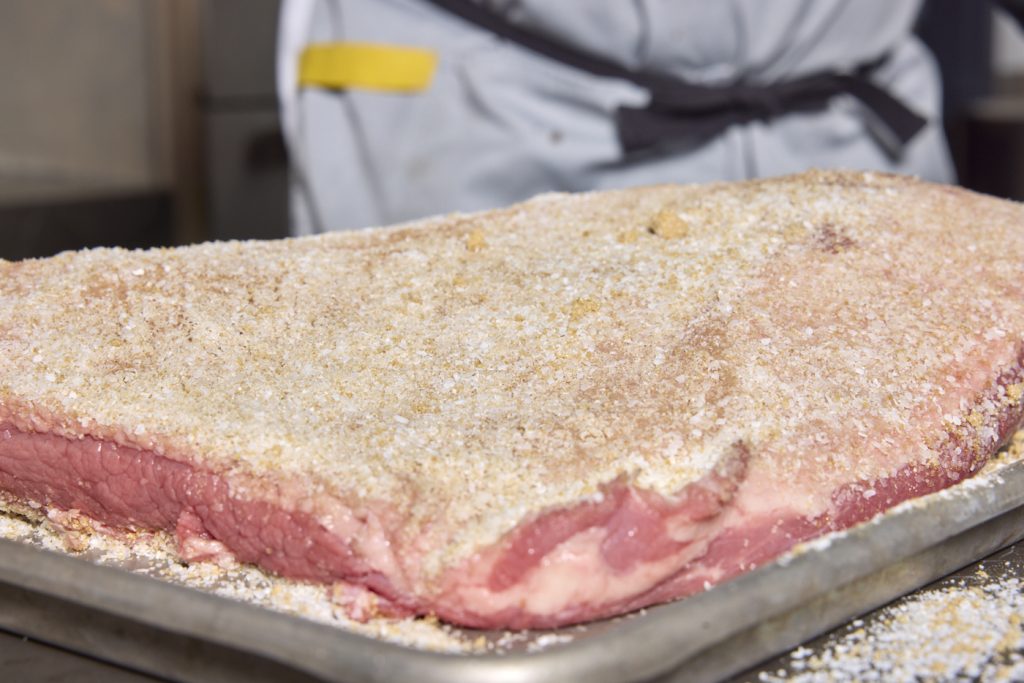
Corning is a common term for the method of curing meat with salt. And while preserving meat by way of salt-curing has been in practice for centuries (the chemical composition inhibits bacterial growth), we mainly cure meat now for the flavor and texture qualities inherent in the process.
To properly cure a brisket for corned beef, Prague powder #1 (pink curing salt) is an essential ingredient. The sodium nitrite slowly decomposes into nitric oxide, which reacts with myoglobin in the meat to create the pink color of the brisket. This reaction is also what gives cured meat its slightly tangy flavor.
Why pink?
Curing salt is pink to distinguish it from table salt. The chemical reaction during curing, not added pink coloring, is what turns the meat pink.
A note on brisket
Beef brisket is one tough piece of meat. This cut is from the pectoral muscle and is heavily worked from bearing much of the animal’s weight. Protein fibers of weight-bearing muscles are very tough and are held together with a web of connective tissue that is primarily comprised of collagen.
The cut’s tough texture and connective tissue require it to be cooked slowly and held for a long time at a relatively high temperature to adequately break down the collagen, transforming it into gelatin. Once gelatin is formed, it can absorb six to ten times its weight in water. Gelatin is essential in arriving at the desired moist and silky texture so commonly associated with tough cuts like brisket and pork shoulder.
How time and temperature matter for cooking corned beef:
For food safety, the meat’s internal temperature only needs to reach 145°F (63°C), but collagen doesn’t begin to dissolve until 160–180°F (71-82°C). Heat applied to the protein needs to be low and slow to keep it tender, but the tender protein won’t matter unless the connective tissue has rendered down to perform its silky magic. For optimal collagen breakdown and gelatin development, we recommend cooking brisket to an internal temperature of 180–205°F (82–96°C). We’ll dive more into the cooking temperatures later, but for now, let’s just say this needs to be cooked more than, say, a steak.
Cooking Corned Beef
Traditional method for cooking corned beef: boil it hard
Once you’ve cured your corn beef, or if you’re using a pre-cured, raw corned beef, it’s time to cook it. But how? The traditional means of preparing corned beef is to put it in a pot and boil it all day, adding cabbage, carrots, and potatoes in the last 40 minutes or so. Thus it has been for generations. Of course, previous generations were notorious for overcooking vegetables, and they also didn’t have the benefit of high-precision thermometry!
Why an all-day hard boil works
Collagen breakdown
As we said above, brisket is tough meat, chock-full of connective tissue. All that collagen makes for chewy corned beef if it isn’t broken down into gelatin, and the long hard boil will get the meat up into the collagen-melting temperature range —above 160°F (71°C)—that it needs to turn that hard, chewy collagen into soft and yummy gelatin.
No stall
If you’ve ever smoked a brisket, you are familiar with the dreaded ‘stall.’ This phenomenon occurs when the collagen in the brisket starts to break down, releasing water. As the water evaporates in the heat of the smoker, it acts as perspiration, and cools the brisket so that the temperature doesn’t rise—sometimes for many hours—and won’t stop until enough water has exited the meat to allow the temperature to rise again. Bother.
Cooking the corned beef by boiling it avoids the stall altogether. If the beef is covered in water, there is no evaporation, and therefore no evaporative cooling. The only route for heat to escape the water directly is through the surface, and a flame under the pot keeps enough heat coming in so that the relatively small amount of heat venting out the top doesn’t hinder your cook.
Easy to do
Putting a slab of beef in a big pot and hitting ‘go’ is about as easy as cooking gets. Busy immigrant families probably thought of this as an ideal way of cooking (except for the cost of fuel for an all-day stove flame) if there were other things to be done.
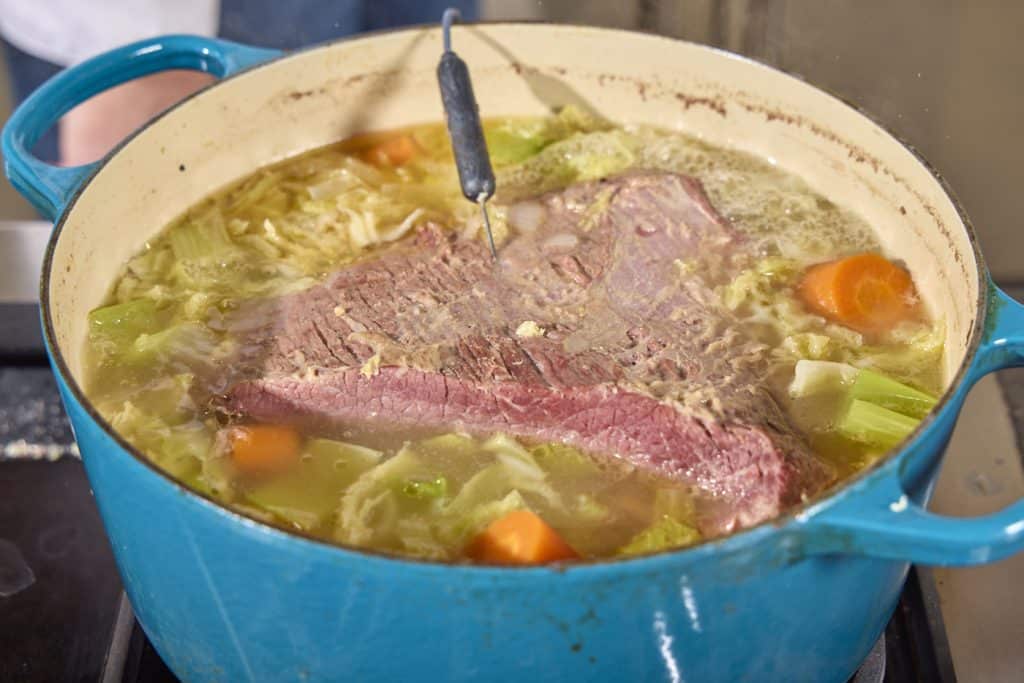
Why an all-day hard boil doesn’t work
Too much breakdown
We all know you can overcook a steak and dry it out—let it hit 150°F (66°C), and you may as well give it to the kids, who don’t know any better. And while brisket can take a much higher temperature than a steak can, it too can be overcooked. If all the collagen turns to gelatin, that’s good, but if all the gelatin cooks out of the corned beef, you’ll just have a crumbly, dried out piece of salted beef. After all, there is no stall, but you’re still cooking it for the length of time you would with a stall!
Flavor loss
Also, boiling meat hard all day is going to leach flavor out of it, leaving it a pale shadow of what it could have been.
What would the ideal method be?
In researching how to achieve corned beef perfection, we looked closely at what J. Kenji López-Alt had to say on the subject. After multiple cooks at multiple times and multiple temperatures, Kenji reported that the best method for his taste preference was to cook the corned beef for ~10 hours at 180°F (82°C). This resulted in the texture that he liked best, with a happy medium between structural breakdown and juiciness.
Mind you, that’s his preference. His experiments showed that you can get a flakier—though somewhat drier—texture by cooking the corned beef at a higher temperature for a shorter time.
What’s going on here?
Collagen breakdown is a function of time and temperature. Once you breach the threshold of gelatin creation—about 160°F (71°C)—the meat will begin to soften. But at that temperature, it will take 36 hours to get tender! At 205°F (96°C), that time is reduced to a mere 3 hours. But because the total internal temp will have climbed so much higher, other protein reactions will have happened that make the meat flakier and drier.
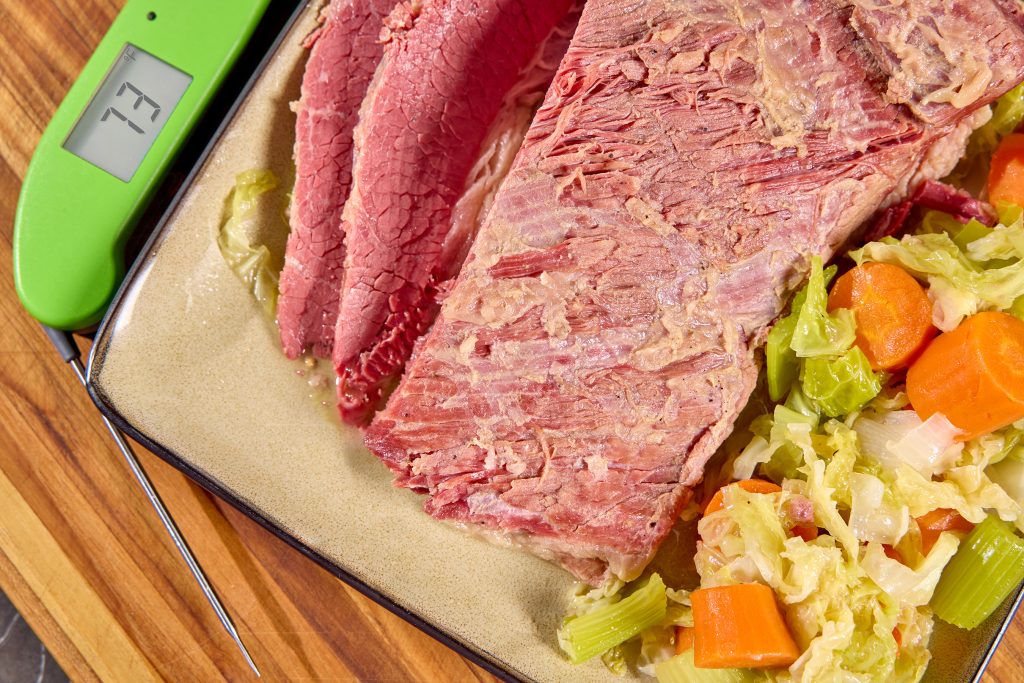
How to cook corned beef perfectly
What we’re looking at here is a fine difference between tradition and modern science. The traditional method is a hard boil all day. The present method is a soft simmer for as little as 3 hours, but up to all day, depending on your textural preference.
To achieve that level of textural accuracy, temperature control is key. So how do you get that control? In principle, you could sous vide it—sous vide is all about careful temperature control. But this recipe for corned beef will be a little too salty, I believe, if you sous vide it. Simmering it in open water draws some of the salt out; vac-sealing it for sous vide will give that salt nowhere to go.
You could also use a slow cooker. Every slow cooker is different, and they all try to maintain different temperatures. If yours keeps a temp that you like for the cook, go for it. But the ThermoWorks demo kitchen doesn’t have a slow cooker, so we broke out the thermometers and rigged up our own system!
We put our beef in the pot and covered it with water. Then onto the stove it went, and we started to monitor the temp once it started to visibly simmer. We tried to maintain a water temp of ~195°F (91°C) in order to balance texture and speed. And because we were taking a more scientific approach to this cook, we used a Smoke X dual-channel thermometer and a Pro-Series Waterproof Needle Probe to monitor both the temperature of the water and the internal temperature of the corned beef. We wanted to know exactly what was going on with both! But if you don’t have a Smoke or ChefAlarm when you cook yours, sporadic monitoring of your water temperatures with an instant-read like the Thermapen ONE will also work.
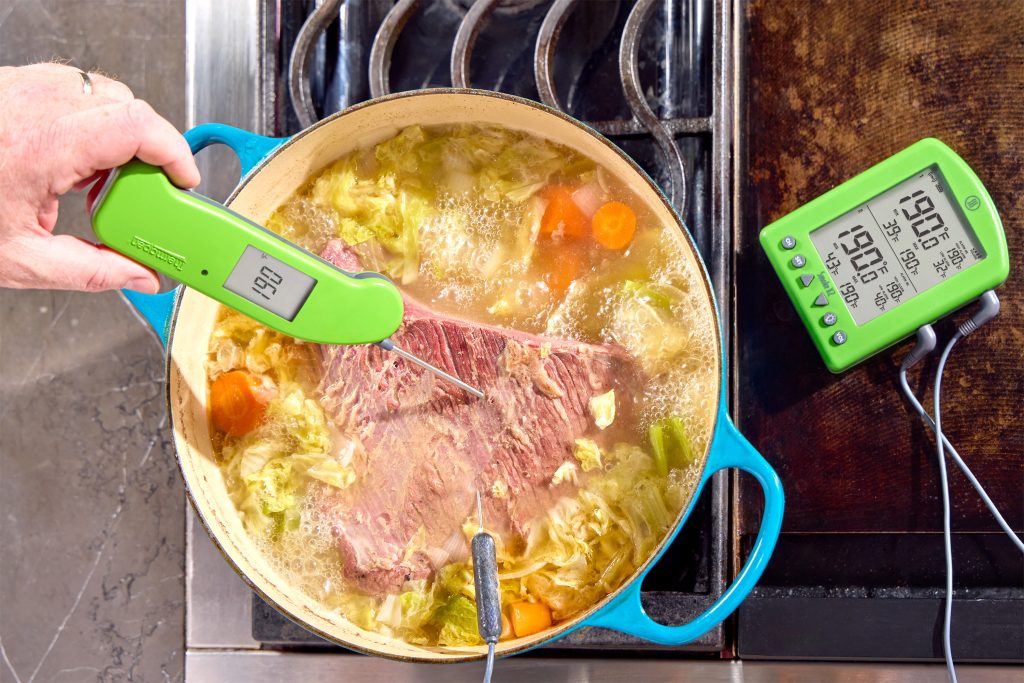
What temperature is corned beef done?
You’ll want to keep your water temperature at a high simmering temp. If you want very firm but tender corned beef that means 180°F (82°C); for flakier but faster corned beef 190-195°F (88-91°C).
Using Smoke’s receiver is nice for this, as you don’t have to be next to the pot to know what’s going on. But until the internal temp of the beef and the temp of the water start to equalize a bit, there’s going to be a lot of back-and-forth on your stove’s heat to maintain the temperature you want.
Once your corned beef reaches the internal temperature you want, it will still need more time for the collagen to break down. Our target temp was 190°F (88°C), and it took 2 hours after reaching that temp for the meat to reach the consistency we wanted. Yours may take more time, depending on your temperature and texture preference. Test it frequently with your Thermapen ONE once it gets up to temp to check for texture. You don’t want it slipping through like nothing is there, but you don’t want to have to exert a lot of force to get the probe through the meat.
And there you have it! Home-cured, carefully cooked corned beef is far better than the commercial stuff you have tried before. And with our temperature hints, a Smoke X, and a Thermapen, you can get exactly the corned beef texture you like!
Print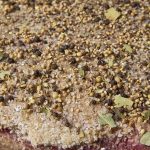
Homemade Corned Beef Cure Recipe
Description
A recipe for curing corned beef, adapted from a Corned Beef Brisket recipe from Kenji Lopez-Alt of Serious Eats.
A note on curing salt: curing salt is to be added by the weight of the meat. For every 5 lb meat, use 1 tsp curing salt. Weigh your brisket, then make the conversion for how much salt you need. Too much curing salt can be toxic, so don’t just assume that if some preserves it, more will do better.
Ingredients
For every 5 lb of brisket (flat or whole):
- 3/4 cup kosher salt
- 1 teaspoon pink curing salt (Prague powder #1, NOT Himalayan pink salt, which is entirely different)
- 2 tablespoons brown sugar
- 1 tablespoon ground ginger
- 2 tablespoons whole black peppercorns
- 1 tablespoon yellow mustard seeds
- 2 tablespoons whole coriander seeds
- 1 tablespoon allspice berries
- 6 whole cloves
- 6 bay leaves, roughly crumbled
Weigh your beef, then do the proper conversion based on this recipe for 5lb.
Instructions
-
- Pat the brisket dry with paper towels.
-
- Combine the salt, pink (curing) salt, ground ginger, and sugar together in a bowl.
-
- Place the brisket in a rimmed baking sheet.
-
- Rub the brisket all over with the salt/sugar mixture. If there is any extra salt mixture, pile it on/under the brisket in the pan.
-
- Combine the spices in a bowl, then crush them coarsely with a mortar and pestle or in a tea towel with a rolling pin
-
- Rub the spices all over the brisket’s surface.
-
- Cover the brisket and pan tightly with plastic wrap.
-
- Place in the refrigerator.
-
- Unwrap it, flip it and rewrap it a few times over the next 7-10 days.
Now you just need to wait 7-10 days…
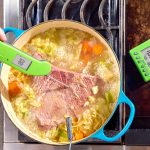
How to cook corned beef: recipe
Description
How to cook corned beef for best texture.
Ingredients
- 1 corned beef
- 1 onion
- 2 carrots
- 2 stalks celery
Instructions
-
- Rinse the excess salt mixture from the corned beef.
-
- Place the beef in a pot. If it’s too big to fit, cut it into smaller pieces and wedge them in together.
-
- Cover the beef with at least an inch of water.
-
- Insert a probe into the beef and either set up another probe temping the water using a pot clip or dangle a waterproof probe in the water directly.
- Set the high-temp alarms for both the water and the meat to 190°F (88°C).
-
- Bring your water up to your target temperature, and maintain it there by adjusting the heat on your burner.
-
- Monitor the internal temp of your corned beef. Once it reaches your target temperature, let the meat cook until it can be easily pierced by a knife—at least 2 hours after the target temp is reached.
-
- You may need to add more water in the course of the cook, as some will be lost to steam. You may also want to weigh the beef down with a bowl or plate if it doesn’t want to stay submerged.
-
- Once your beef is nearly tender enough, add the vegetables to the pot and simmer them together for at least 20 minutes, or until they reach the texture you like.
-
- Remove the beef from the pot and let it cool enough to handle.
-
- Slice the beef to your liking, and serve with the cooked veggies and some good mustard.
For the perfect complement to Corned Beef on St. Patrick’s day, see our Irish Soda Bread post.
For another way to cook your corned beef, check out our post on Smoking Corned Beef!


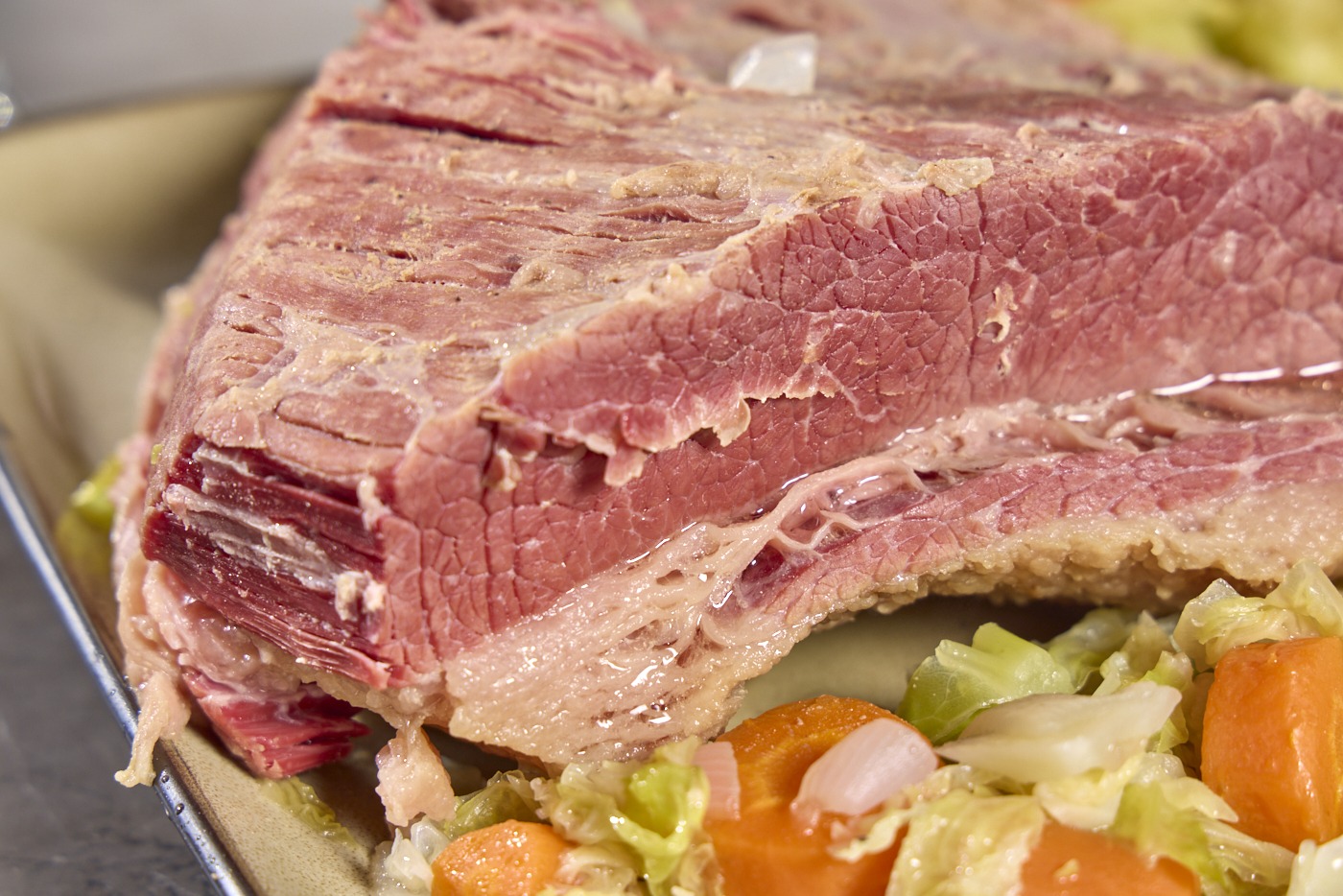
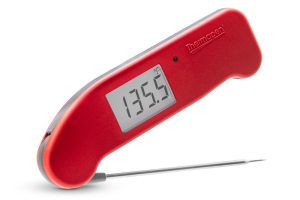
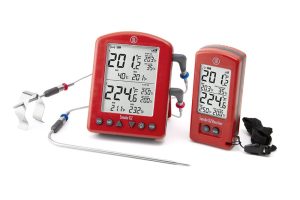
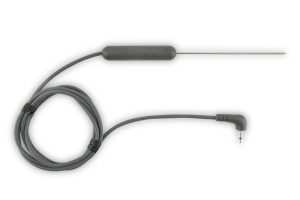
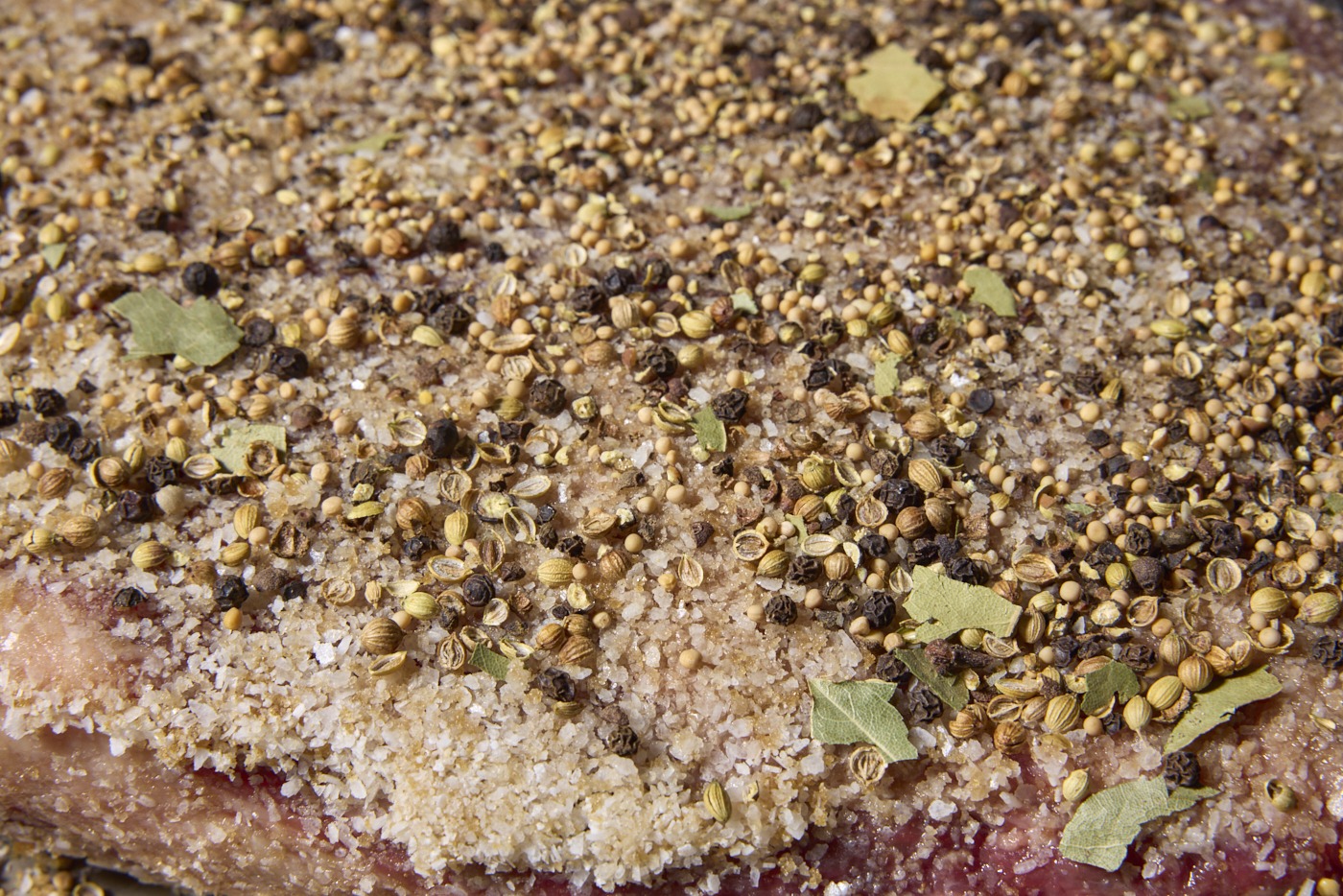
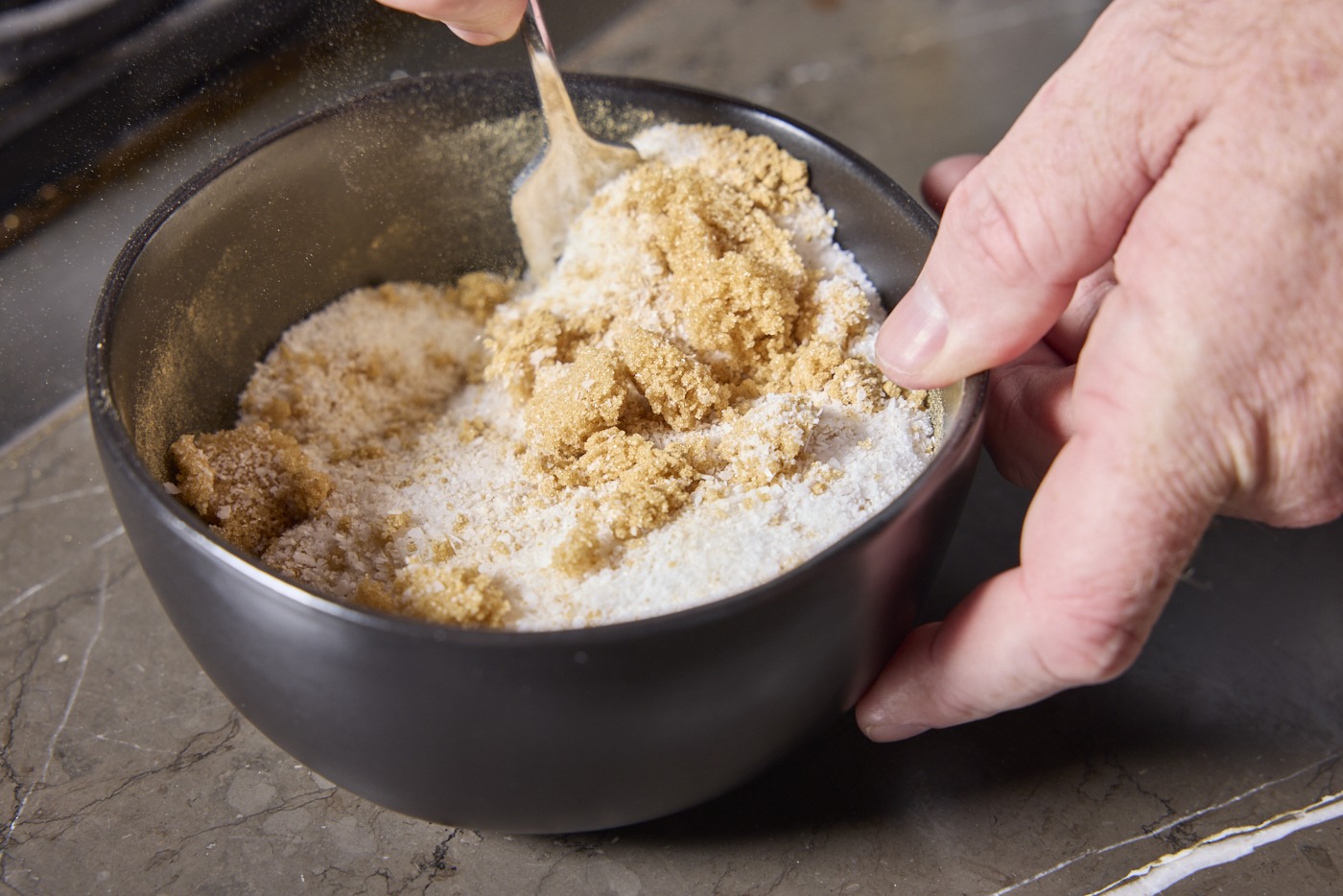
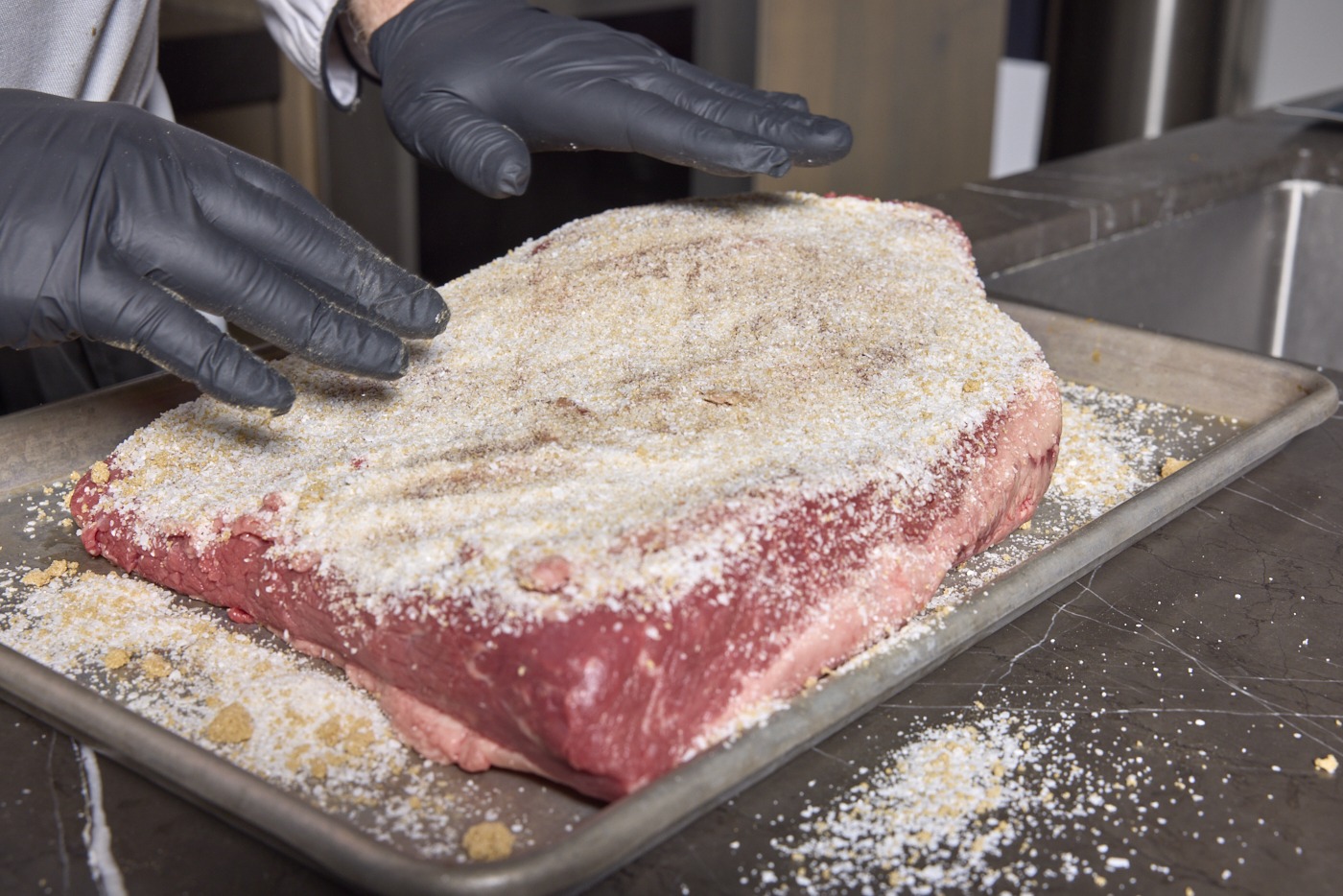
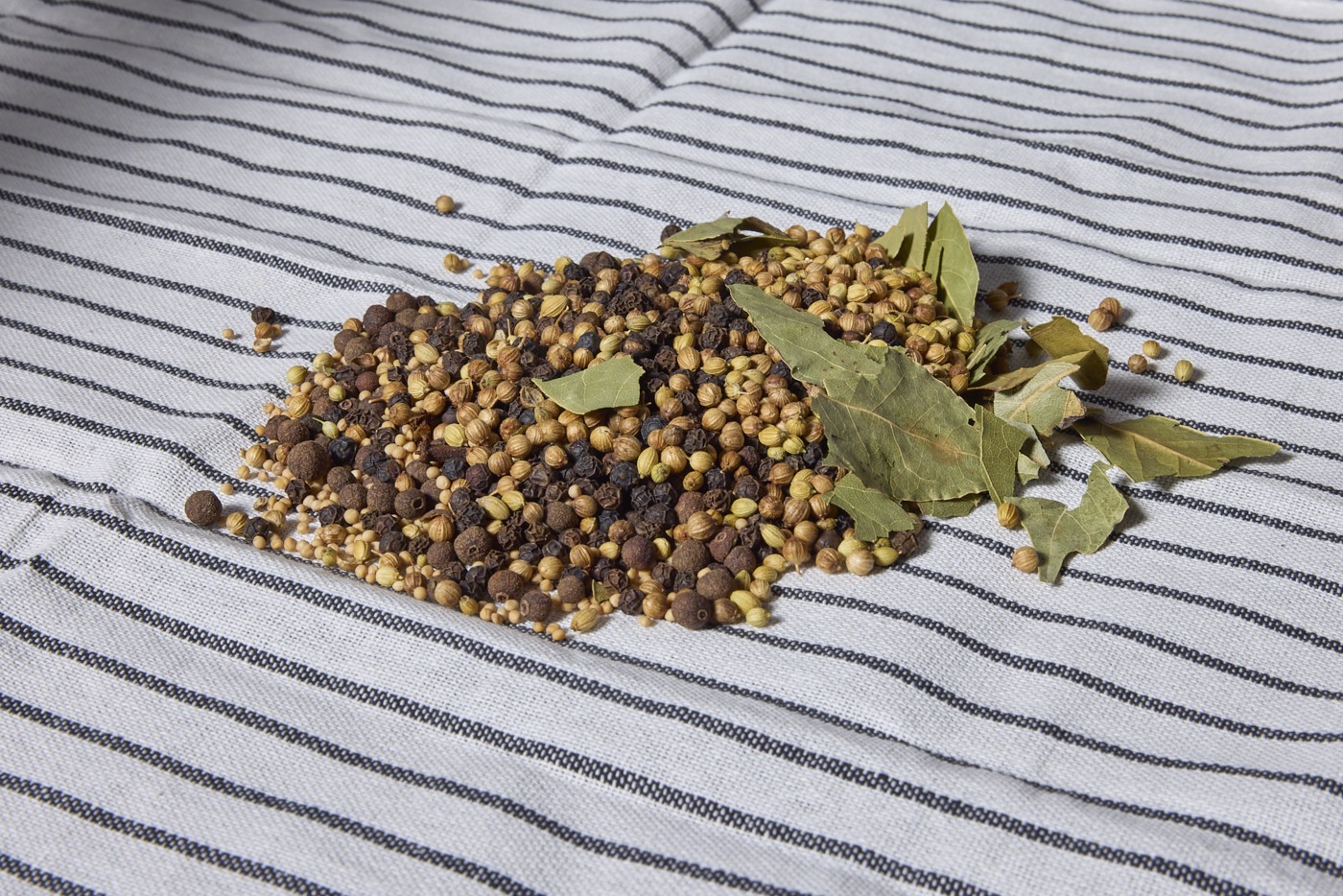
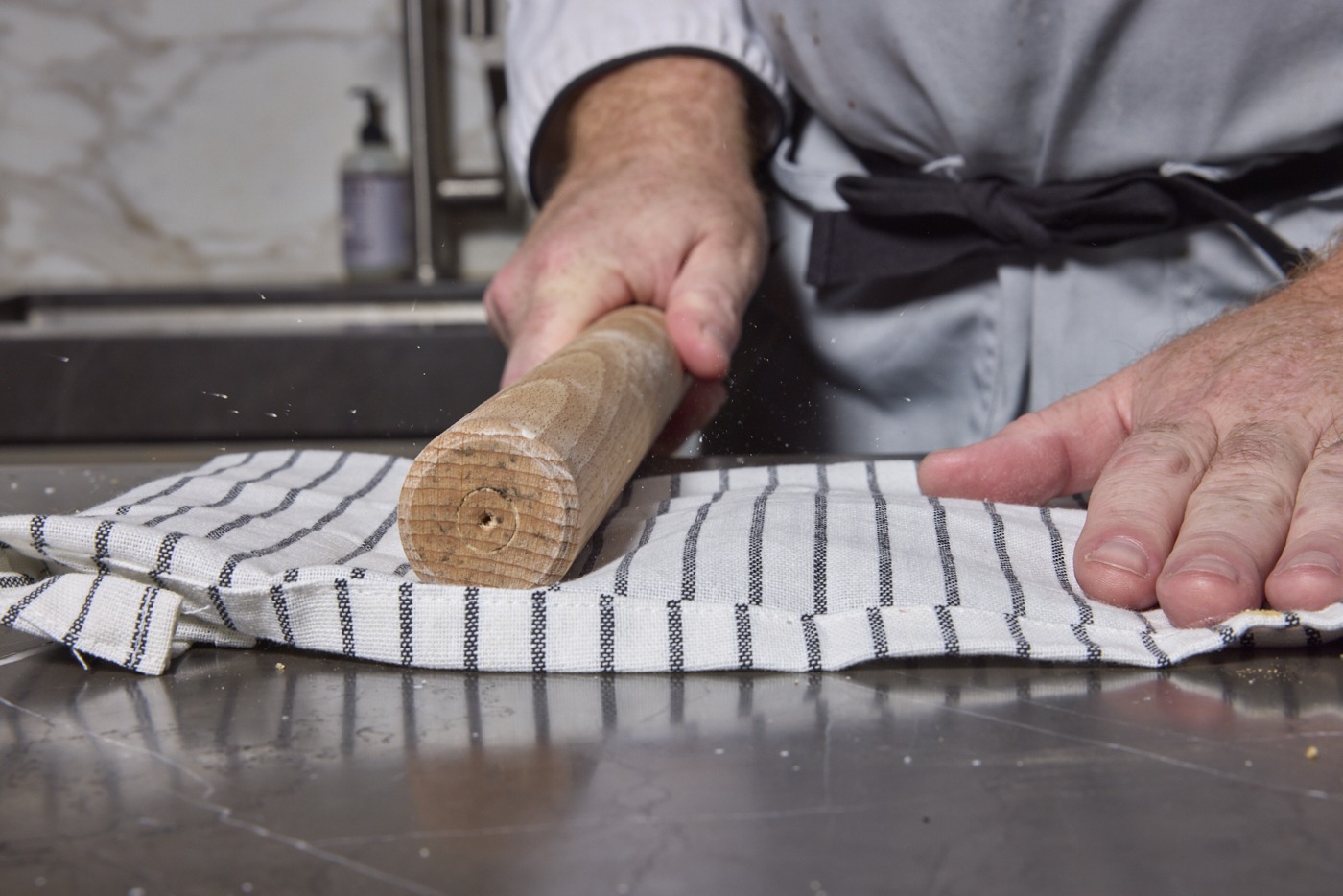
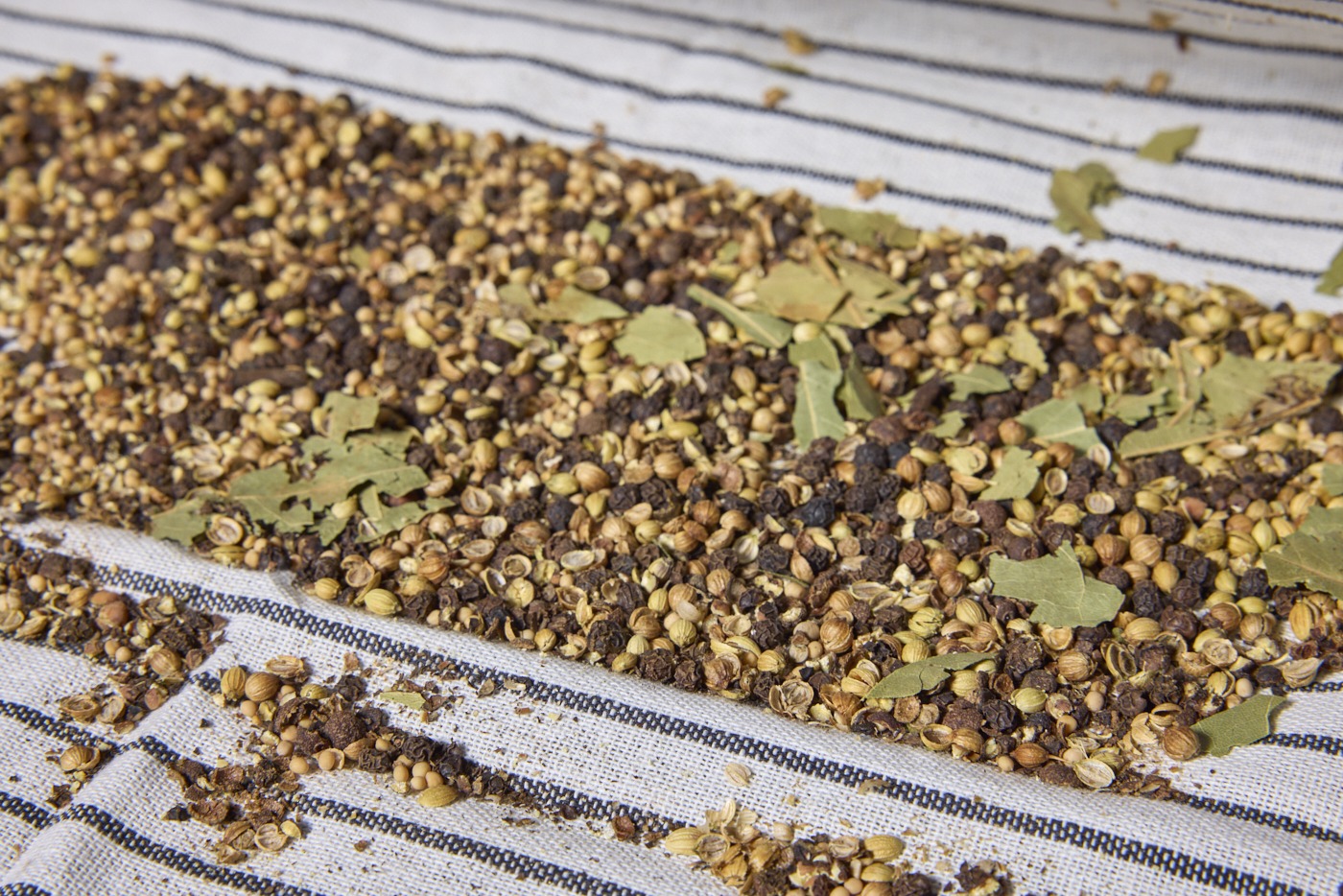
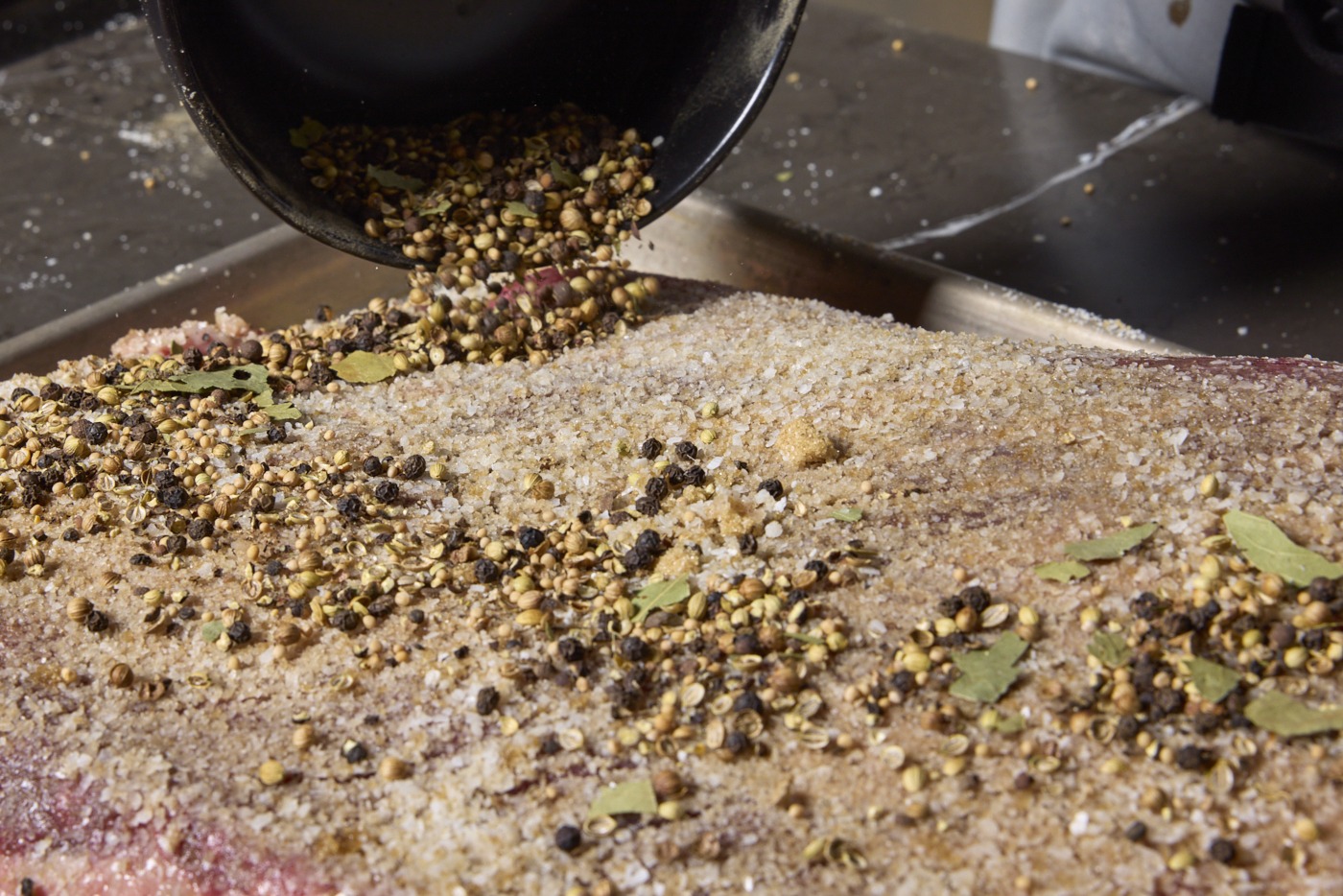
EXCELLENT article. Thanks so much.
Harvey,
Glad you enjoyed the article! This was a fun project for us to work on.
-Kim
What is the cooking procedure for a pressure cooker?
Basem,
Great question! This recipe from Pressure Cooking Today goes through how to prepare corned beef in a pressure cooker. You could follow the corning instructions in our post, and continue on with the rest of the recipe after using your pressure cooker. It’ll certainly speed up the process!
Thanks,
-Kim
Question…after you boil the brisket, do you drain the water? Do you just leave it in the Dutch oven or put it on a broiling pan? Everything else sounds pretty straightforward, but having trouble following that part of the process…
Thanks!
Guy
Guy,
I’m sorry the process wasn’t more clear to understand. After the brisket is brought to a boil on the stovetop it’s transferred directly into the oven–still submerged in water in the Dutch oven. After cooking in the oven the brisket is allowed to rest in the cooking liquid. I hope this helps. Please don’t hesitate to ask any more questions you may have.
Thanks!
-Kim
Harvey,
Glad you enjoyed the article! This was a fun project for us to work on.
-Kim
Guy,
I’m sorry the process wasn’t more clear to understand. After the brisket is brought to a boil on the stovetop it’s transferred directly into the oven–still submerged in water in the Dutch oven. After cooking in the oven the brisket is allowed to rest in the cooking liquid. I hope this helps. Please don’t hesitate to ask any more questions you may have.
Thanks!
-Kim
It was not clear at all that the pot is transferred to the oven. Yet years later the recipe is still not edited for clarity. At what oven temperature? And how is that different from braising? Thank you.
It is braising, just…oven braising. Keeping the oven at 250°F will keep the water about where we want it to be. But you can also do this on the stove, just monitor the temps as you go!
Basem,
Great question! This recipe from Pressure Cooking Today goes through how to prepare corned beef in a pressure cooker. You could follow the corning instructions in our post, and continue on with the rest of the recipe after using your pressure cooker. It’ll certainly speed up the process!
Thanks,
-Kim
I enjoy your emails and information but I find it difficult to print and save the information
James,
The current format we have isn’t the most user-friendly, and we’re working toward restructuring some areas of our website. Thank you for your feedback!
Sincerely,
-Kim
You state that it can take from 8 to 10 hours to cook to reach a tender stage. How does one know when it’s tender enough, and not overly tender that it falls apart?
Nathan,
You make a good point. The larger the piece of meat, the longer it will take to reach target temperatures and judge doneness. Check out this article by Steven Raichlan about Brisket FAQs. He has a couple of tips, but one is to insert a thermometer probe inside the meat. It should go in out without any resistance–like butter. Best wishes with your corned beef cook!
Thanks,
-Kim
I cooked mine differently as per another source and it turned out amazingly good. Smoked the meat at 240 deg until the internal temp reached 160 deg. Then I wrapped it with foil (I do the same for ribs) which will keep the juices in the meat and tenderizes it. The temp rose from 160 to 180 deg in about 1.5 hours. Then coated it with a glaze and cooked it until the internal temp reached 195. Let it rest for 30 minutes. The meat was very tender and tasted great by itself. The next day my wife made the corn beef and cabbage meal which always is great. Definitely a recipe that I will add to my “Favorites” list.
Bob,
Your smoked method sounds wonderful! The temp ranges you mentioned are so critical that tough piece of meat. There really are so many different ways to prepare a brisket whether it’s corned, smoked, cooked sous vide, or simmered. Thank you for sharing!
-Kim
Bob,
Your smoked method sounds wonderful! The temp ranges you mentioned are so critical that tough piece of meat. There really are so many different ways to prepare a brisket whether it’s corned, smoked, cooked sous vide, or simmered. Thank you for sharing!
-Kim
James,
The current format we have isn’t the most user-friendly, and we’re working toward restructuring some areas of our website. Thank you for your feedback!
Sincerely,
-Kim
Nathan,
You make a good point. The larger the piece of meat, the longer it will take to reach target temperatures and judge doneness. Check out this article by Steven Raichlan about Brisket FAQs. He has a couple of tips, but one is to insert a thermometer probe inside the meat. It should go in out without any resistance–like butter. Best wishes with your corned beef cook!
Thanks,
-Kim
I heard from a butcher friend that the use of celery salt may be just the same as pink salt. Is this true. Our conversation was on… Should I say it.. Nitrates. Easy now! I just want to know about the celery substituting pink salt.
Justin,
Great question! It looks like celery salt, or cultured celery powder, is used as an alternative to curing salt–they aren’t the same thing. The cultured celery powder contains some preformed nitrites. Check out this article from Malabar Spice. If you give it a try let us know how it goes!
Thanks,
-Kim
Justin,
Great question! It looks like celery salt, or cultured celery powder, is used as an alternative to curing salt–they aren’t the same thing. The cultured celery powder contains some preformed nitrites. Check out this article from Malabar Spice. If you give it a try let us know how it goes!
Thanks,
-Kim
Great article. I love corn beef on rye. must be the Irish in me!
Stanley,
Nothing really compares to well-made corned beef. Glad you liked the article.
Thanks!
-Kim
Stanley,
Nothing really compares to well-made corned beef. Glad you liked the article.
Thanks!
-Kim
I cure the meat in liquid for 1 1/2 to 2 weeks, using a similar spice mix to yours. I toast the spices lightly and grind them in a mortar to release more flavor.
I always boiled it and didn’t think to use my ThermaPen. The poke-it-with-a-fork method has worked for years and I got no complaints. Maybe I’ll shake it up and get scientific this year.
I love the idea of toasting and grinding the spices first. Excellent tip!
We get good results using our slow cooker with a mixture of Guinness, brown sugar,home made pickling spice,two split heads of garlic and one quartered onion cooked on low setting around five hours.Never took an Internal,always went by feel but will use my “Smoke” this time to compare.We sear cabbage wedges in bacon fat then some cooking liquid,carrot and taters put on a lid till crisp tender.Say no to soggy veg.Also flats and points cook different from one another,we like points for fat content.
Happy Cooking!
“Say no to soggy veg.” Love it!
Love your detailed article. I like to keep my corned beef for a few days for sandwiches or just to munch on. Will it stay moister if I slice it and store it in a Tupperware covered with the cooking liquid or will it stay moister than if I put it in the container dry?
It should stay moister in the cooking liquid.
There are so many temperatures discussed in this article-I’m confused! The water temp should be 195°, but maybe 180?
For the meat temp, I don’t understand this sentence. “Once your corned beef reaches the internal temperature you want, it will still need to have time for the collagen to break down. Our target temp was 190°F (88°C), and it took 2 hours after reaching that temp for the meat to reach the consistency we wanted. Yours may take more time depending on your temperature and texture preference.”
What is the range of internal temp I may want? Target temp 190°, but after you reached 190°, it took 2 more hours? To what eventual temp?
Thank you.
Jane,
Good questions, I see that is less clear than it seemed when I wrote it. You can cook it in water that is at 180°F for much longer, but I like it closer to 195°F. The meat will equalize with the water temperature, but just because it bets up to that temp doesn’t mean that it is already tender…not necessarily.
If you cook it at 180°F it will take several hours to get tender enough. If you cook it at 190 it will go faster. You’ll hit “water temp” and then need to hold it at that temp for more or less time, depending on your textural preference.
The temperature here is giving us a guide to making sure we don’t overcook it and boil all the gelatin out of it.
If I’m not mistaken, when smoking corned beef, it becomes pastrami. Correct me if I am wrong.
Close! Pastrami also needs to be coated in a pepper/coriander/spice mixture.
I cooked two corned beef roasts, both about 4 lbs, one using Lopez-Alt’s method and one using the simmering method in this article. I used a Joule sous vide unit and a Thermoworks Smoke X2 to monitor the temperature for the first, and a Samsung induction cooktop and the Smoke X2 for the second.
The Lopez-Alt recipe was crap. After 8 hours (not 10) at a rock-solid 180F, the meat was cooked to the consistency of baby food. Even allowing it to cool overnight in its bag didn’t improve it. I can’t believe anyone wants it this way.
So my meal was screwed. now I had to cook the second one and have the NE Boiled Dinner on the 18th.
So the next day I try again using the Thermoworks simmering recipe. Reach an internal temp of 190, hold two hours. Similar results though not as bad. Overdone, overdone. Tasted fine but would not hold un for slicing for a sandwich.
I’m sorry it didn’t work out for you. A shorter hold time at the temperature will make it more sliceable. I’m glad it at least tasted good!
I have oven braised corned beef in the past with great results, but can’t now find a recipe that looks “right.” What would you recommend for oven-braising, or don’t you, and why?
I’d use a large braising vessel and add hot liquid to come 1/2 to 3/4 of the way up the meat. Add onions, celery, and carrots to the liquid. Cook, covered, in an oven set to 325. use a probe and set the target temp for 175. When that alarm sounds, set a timer for 2 hours and continue to cook. Flip the meat over in the braising liquid every 90 minutes thorughout the cook to extract the salt form the emat evenly. Should be great!
I found that simmering seemed to loose to much flavor from the corned beef, so I use the braising method in the oven then I use the liquid to make up the veggies. I’m surprised that this method wasn’t mentioned. I did like the article it gave me a lot of info.
Will the Square Dot oven temp probe also monitor water temp averages?
Yes! But you might wan to use the optional waterproof needle probe for that. It works just as well with the Square DOT, but is meant for submersion.
Please comment on Corning other cuts of meat. Such as top round or eye of round.
Use the same process, but know that a thicker cut like an eye or round will take longer to cure to the center. Adjust the ingredient quantities based on weight. One difficulty would be in the cooking. A long slow braise is great for corned beef because it leeches out some of the excess salt, but an eye of round makes a terrific mediun-rare roast. That will be one salty roast! In general, we tend to salt cure meats that can take some serious cooking (ham and bacon, even), not our steakier cuts. But maybe eye of round “ham” will be good! If you try it let us know how it goes.
Corned beef WAS historically produced in Ireland, and was known as a superior product during the time of the British Empire. However, it became too expensive for the Irish to buy. Ironically after emigrating to the United States, it was cheaper to purchase. But the process did not original with Jewish Americans as you seem to suggest.
https://www.foodandwine.com/news/complicated-irish-history-corned-beef
How about a similar article for cooking a brisket by braising it (not for corned beef)?
We have one! check out our braised brisket post!
Using an induction stove top that allows you to set the temperature could allow us to set the temp to 190 exactly? Does that sound reasonable?
Yes! But verify that it is doing that. Not all induction tops are as honest as we hope them to be.
My method: slow cooker, couple of bottles of Guinness, sliced Vidalia onions on the bottom, the meat, on high for about 3-4 hours, then to low for a couple more. Last hour or 2 before mealtime in go the veggies. No complaints yet. Ronnie.
The corned beef cooked your way with all the vegetabes in with the meat is the way my mother cooked/served as a soup with the corned beef cut up.
I buy my corned beef from the grocery store I don’t brine mine own.
I put my store bought corned beef in a large pan, cover it with at least an inch of water and add extra pickling spices to the water because the package in with the corned beef isn’t enough.
I take the corned beef out of the boiling liquid when it is tender and put it in a baking dish. I then mix up ketchup, brown sugar, and mustard for a glaze. I cover the corned beef with the glaze mixture and put it in a 325 degree oven. I get the vegetable ready while the corned beef is in the oven.
I then add the potatoes and carrots to the cooking liquid and cook until almost done then add the quartered cabbage to the liquid to cook.
I take the corned beef out of the oven and let it rest a few minutes while I dish up the vegetables and then slice the corned beef with the glaze. I usually cook it in the oven for about 20 minutes or until the glaze looks cooked.
I learned the glaze method from my mother in law 50 years ago. It compliments the wonderful flavor of the corned beef. And it also make great left overs for sandwiches.
What are your recommendations for trimming a flat prior to the corning process? Leave fat on, trim to 1/4 – 1/2 inch or skin it off?
The instructions for the instant pot cook say to leave fat on the bottom of the flat.
I like some fat cap on there, but it’s entirely up to personal taste. Let’s say, 1/4″.
Sadly, no thermometers required for it, but pressure cooking the brisket comes out amazing. 90 minutes in an Instant Pot or similar brand makes the best corned beef I’ve ever had. I make sure I rinse the hell out of the pre-cured briskets beforehand. Not too salty tasting at all. Using my cheapo Best Buy home meat slicer produces perfect slices, even though I don’t look forward to cleaning the slicer afterwards.